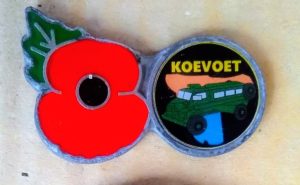Armistice Day: Remembrance or Poppy Day.
Abstract
Armistice Day, 11 November 1918, remains deeply relevant to the SANDF, South African Police and Koevoet Veterans League because it symbolizes the origin of modern remembrance culture, honours shared military sacrifice, and connects their legacy to a broader tradition of service and loss
ARMISTACE DAY: REMEMBERANCE OR POPPY DAY.
Willem Botha

11 November 1918. Why is this date, so far in the past, relevant to the South African Police in general and the Koevoet Veterans League in particular?
Background: World War 1 began in 1914; hostilities stopped after a ceasefire was declared on the 11th hour of the 11th day of the 11th month in 1918. WW1 formally ended with the signing of the Treaty of Versailles on 28 June 1919. It is impossible to determine how many people lost their lives in what is believed to be one of the deadliest wars in human history. According to estimates about 8.5 million soldiers and up to 7 million civilians were killed. As many as 21 million plus soldiers were wounded!
Both the SA Legion, Est. 1921, in Cape Town, a member of the British Empire Service League as well as the MOTHS (Memorable Order of the Tin Hats) Est. 1927 in Durban were founded by WW1 veterans as a brotherhood of ex-service men and women. Their primary objectives to remember the fallen, promote camaraderie, supporting and care for war veterans as well as dependants focussing on South African servicemen and women. Both organisations have branches world-wide.
Globally several organisations have similar objectives to support war Veterans. By hosting solemn occasions like the Armistice, it is intended to keep the noble aspirations alive.
These days several established Veteran organisations and certain Trusts oversee such events in South Africa’s democratic dispensation as well.
Following the end of WW2 in 1945 and the Korean war in 1953 numerous armed conflicts continued globally. It is calculated that more than 50 armed battles are currently being fought worldwide, many regularly featured on our TV and radio news reports. Like WW1 the subsequent wars resulted in countless military as well as civilian loss of lives that are today also honoured during Poppy Day remembrance services and parades.
Poppy Day: Typically, people wear poppies to show respect and solidarity during this time. Displaying Poppies on Armistice Day is a universal practice that originated from the 1915 poem “In Flanders Fields.” The poem describes the resilient red poppies that grow in the fields of Flanders, a region in Belgium, where many soldiers died during World War I.
Remembrance Day ceremonies and parades to honour those who have served and sacrificed normally follow a program where:
A bugler plays Reveille and the Last Post to signal the start and end of the ceremony.
This annual tradition includes a two-minute silence at 11 am on November 11, symbolizing the moment when the armistice took effect to honour the sacrifices by members of the armed forces and civilians during the war.
A wreath-laying ceremony to honour the fallen, often led by dignitaries, veterans, as well as family members.
The significance of Armistice Day that pay tribute to veterans and their sacrifices are explained signifying the lasting spirit of camaraderie as well as the importance of freedom and peace.
Fundraising activities to support veterans and their families take place.
World War I came to an end over 106 years ago, World War II already eighty years in the past. Today only a handful of WW2 veterans from the great wars are still alive, their numbers declining fast. Hard work recruiting new members to increase the MOTHS and similar organisations association figures consequently turned out to be essential. Membership to these organisations is welcomed notwithstanding diverse military experience or background.

11 November 1918. So, why is this date, so far in the past, relevant to the South African Police in general and the Koevoet Veterans League in particular?
Many SA Policemen served their country, participating in various campaigns supporting the wider Allied war effort with honour during the Great World Wars. Common interest in addition to an enduring spirit of camaraderie consequently binds past and present combatants, uniting war Veterans worldwide to celebrate this day as the important historical event it is.
Poppy Day likewise evolved over the years to honour Veterans who served in scores of other global conflicts, including the SWA Border War where the SA Police COIN units as well as Koevoet discharged their responsibilities with distinction.
In this context The Koevoet Veterans League also pay tribute to 165 off their own who did not come home during a yearly wreath laying ceremony and flag parade at the Koevoet Wall of Remembrance, Voortrekker Monument in Pretoria.
Pertaining to this, even though the annual commemoration of Armistice Day is not directly linked to Koevoet, 11 November 1918 is relevant because it is the fifth of five (5) annual memorial events observed by the Koevoet Veterans League.
More than a few Koevoet Veterans have joined the MOTHs in their respective regions or provinces where they attend the annual MOTH Remembrance Day services and parades. Koevoet old hands living or working abroad will join local ceremonies. Members who cannot attend organized events may well light a candle paying homage to those who made the ultimate sacrifice during bygone wars.
Salutations!
(Willem Botha 2024)
![]()